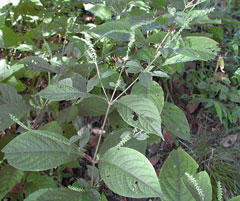 |
|
Kazuo Yamasaki http://home.hiroshima-u.ac.jp/shoyaku/PlantPhotos2002.htm |
 |
|
Translate this page:
Summary
Physical Characteristics

 Achyranthes japonica is a PERENNIAL growing to 1 m (3ft 3in). It is in flower from July to September, and the seeds ripen from September to October. The species is hermaphrodite (has both male and female organs).
Achyranthes japonica is a PERENNIAL growing to 1 m (3ft 3in). It is in flower from July to September, and the seeds ripen from September to October. The species is hermaphrodite (has both male and female organs).
Suitable for: light (sandy) and medium (loamy) soils. Suitable pH: mildly acid and neutral soils. It can grow in semi-shade (light woodland) or no shade. It prefers moist soil.
UK Hardiness Map
US Hardiness Map
Synonyms
Plant Habitats
Woodland Garden Sunny Edge; Dappled Shade; Shady Edge;
Edible Uses
References More on Edible Uses
Medicinal Uses
Plants For A Future can not take any responsibility for any adverse effects from the use of plants. Always seek advice from a professional before using a plant medicinally.
Abortifacient Analgesic Antiinflammatory Antispasmodic Contraceptive Diuretic Hypotensive Uterine tonic
The root of the plant is used in Korea to treat oedema, rheumatism, delayed menses and as a contraceptive and abortifacient[279]. The root contains triterpenoid saponins and has been shown to have analgesic, antiallergic, antiinflammatory, antispasmodic, diuretic, hypotensive and uterine stimulant properties[279]. In addition, it contains protocatechuic acid, which has antioxidant properties, and also inhibits the aggregation of platelets[279].
References More on Medicinal Uses
The Bookshop: Edible Plant Books
Our Latest books on Perennial Plants For Food Forests and Permaculture Gardens in paperback or digital formats.

Edible Tropical Plants
Food Forest Plants for Hotter Conditions: 250+ Plants For Tropical Food Forests & Permaculture Gardens.
More

Edible Temperate Plants
Plants for Your Food Forest: 500 Plants for Temperate Food Forests & Permaculture Gardens.
More

More Books
PFAF have eight books available in paperback and digital formats. Browse the shop for more information.
Shop Now
Other Uses
Two insect-moulting hormones are found in the seeds[279]. Can this have a practical application as an insecticide?
Special Uses
References More on Other Uses
Cultivation details
We have very little information on this species and do not know if it will be hardy in Britain. However, judging by the plants native range, it is likely to succeed outdoors at least in the milder areas of the country. The following notes are based on the general needs of the genus. Prefers a rich, sandy, slightly acid soil in partial shade[238].
References Carbon Farming Information and Carbon Sequestration Information
Temperature Converter
Type a value in the Celsius field to convert the value to Fahrenheit:
Fahrenheit:
The PFAF Bookshop
Plants For A Future have a number of books available in paperback and digital form. Book titles include Edible Plants, Edible Perennials, Edible Trees,Edible Shrubs, Woodland Gardening, and Temperate Food Forest Plants. Our new book is Food Forest Plants For Hotter Conditions (Tropical and Sub-Tropical).
Shop Now
Plant Propagation
Seed - sow late spring in a greenhouse. Germination should be fairly rapid, prick out the seedlings into individual pots of fairly rich soil when they are large enough to handle. It is probably wise to grow this plant on in the greenhouse for its first winter, planting it out into its permanent position in late spring after the last expected frosts.
Other Names
If available other names are mentioned here
Native Range
TEMPERATE ASIA: Japan (Honshu, Kyushu, Ryukyu Islands, Shikoku)
Weed Potential
Right plant wrong place. We are currently updating this section.
Please note that a plant may be invasive in one area but may not in your area so it's worth checking.
Conservation Status
IUCN Red List of Threatened Plants Status :

Growth: S = slow M = medium F = fast. Soil: L = light (sandy) M = medium H = heavy (clay). pH: A = acid N = neutral B = basic (alkaline). Shade: F = full shade S = semi-shade N = no shade. Moisture: D = dry M = Moist We = wet Wa = water.
Now available:
Food Forest Plants for Mediterranean Conditions
350+ Perennial Plants For Mediterranean and Drier Food Forests and Permaculture Gardens.
[Paperback and eBook]
This is the third in Plants For A Future's series of plant guides for food forests tailored to
specific climate zones. Following volumes on temperate and tropical ecosystems, this book focuses
on species suited to Mediterranean conditions—regions with hot, dry summers and cool, wet winters,
often facing the added challenge of climate change.
Read More
Expert comment
Author
(Miq.)Nakai.
Botanical References
266
Links / References
For a list of references used on this page please go here
Readers comment
| Add a comment |
|
If you have important information about this plant that may help other users please add a comment or link below. Only comments or links that are felt to be directly relevant to a plant will be included. If you think a comment/link or information contained on this page is inaccurate or misleading we would welcome your feedback at [email protected]. If you have questions about a plant please use the Forum on this website as we do not have the resources to answer questions ourselves.
* Please note: the comments by website users are not necessarily those held by PFAF and may give misleading or inaccurate information.
To leave a comment please Register or login here All comments need to be approved so will not appear immediately.
|
Subject : Achyranthes japonica
|
|
|
|